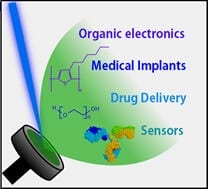 Rodney Priestley and Kimberley Shepard, of Princeton University, NJ, report on the use of matrix-assisted pulsed laser evaporation (MAPLE) for processing of polymer thin films with control over, for example film thickness, structure morphology, surface roughness in this recent Trend article in Macromolecular Chemistry and Physics.
Rodney Priestley and Kimberley Shepard, of Princeton University, NJ, report on the use of matrix-assisted pulsed laser evaporation (MAPLE) for processing of polymer thin films with control over, for example film thickness, structure morphology, surface roughness in this recent Trend article in Macromolecular Chemistry and Physics.
Applications of macromolecular systems deposited by MAPLE include sensors, organic electronics, drug delivery, and biocompatible coatings for medical devices and implants.
Professor Priestley, a 2013 Diverse Emerging Scholar at Princeton University, obtained his Ph.D. in Chemical Engineering from Northwestern University in 2008 and joined Princeton after post-doctoral work at the Ecole Superieure de Physique et Chimie Industrielles de la Ville de Paris in France. Ms. Shepard is working towards her Ph.D. in chemical and biological engineering in Prof. Priestley’s group.
MAPLE is a versatile deposition technique, introduced in 1999, and can be used for small molecules and nanoparticles, as well as for macromolecular systems. It enables additional control over film-growth processes, as compared with other methods.
In the MAPLE method, a laser beam strikes a target, which is made of a frozen solution. When the laser beam hits the target, a plume of solvent and polymer is formed. The process takes place under high vacuum, so the solvent is pumped away, and just the polymer is collected on a substrate, gradually forming a thin film.
In the article, the experimental setup of MAPLE and the mechanism of film formation and early work on MAPLE are discussed, recent trends from the point of view of applications of films grown by the technique are explored and future directions and challenges are addressed.

















